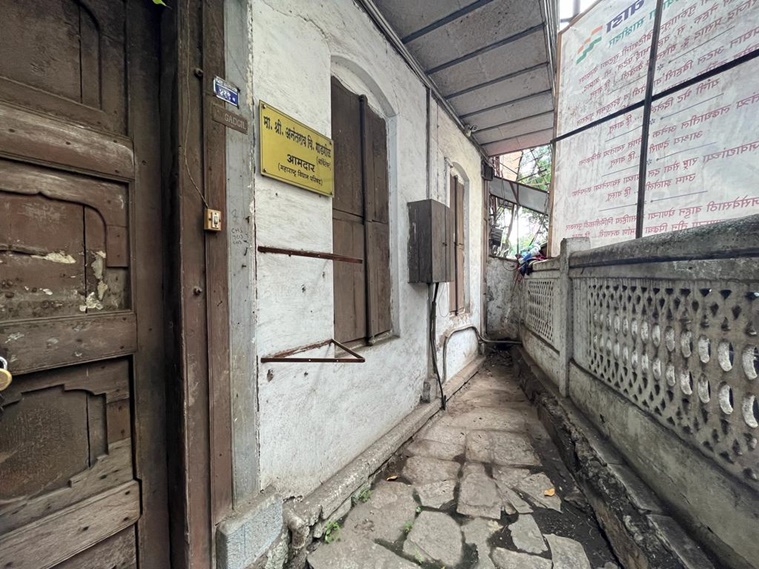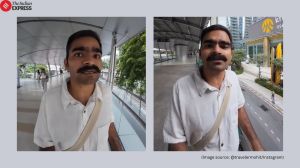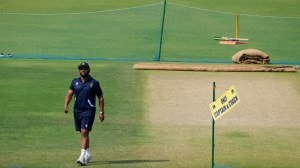Know Your City: A 90-year-old home in Pune guards a legacy of friendly political rivalries, going beyond party lines and ideologies
From Jawaharlal Nehru to Atal Behari Vajpayee, Pune’s Gadgil Wada has welcomed several Indian Prime Ministers since it was built in 1930 by Narhar Vishnu Gadgil or Kakasaheb Gadgil, a Gandhian freedom fighter.
 Shri Anantrao Gadgil Wada, Kakasaheb Gadgil road. (Express photo by Oshwin Kadhao)
Shri Anantrao Gadgil Wada, Kakasaheb Gadgil road. (Express photo by Oshwin Kadhao)“Where in Pune is Gadgil Wada located?” Former Prime Minister Atal Behari Vajpayee had asked the owner of the house, the eminent Congress politician V N Gadgil, this question as he was visiting the city and wanted to drop in at the wada that had played a prominent role in the history of India. “There is no need of a postal address,” Gadgil had replied to his friend and political rival from the BJP. “Come to a place called Shaniwar Peth, which is an RSS desert, and the only oasis you will find will be my house,” he said.
Gadgil Wada had been built in 1930 by Narhar Vishnu Gadgil, better known as Kakasaheb Gadgil, a Gandhian freedom fighter. Vajpayee was not the only leader who was keen to pay a call to the wada. Over the decades, the mighty wooden gates that have stood the test of time have welcomed most former prime ministers, such as Chandra Sekhar and I K Gujral, the latter when he was in office. The leaders were literally treading in the footsteps of stalwarts such as Jawaharlal Nehru, Vallabhai Patel and Maulana Abul Kalam Azad who used to come to the house to meet, strategise and, before 1947, hide from the British police. Despite clashing ideological colours, many political leaders accept the importance of events that took place at Gadgil Wada.
Varied opinions flourished at the wada. Its location, half a km from Motibaug, an RSS hub, has not come in the way of the residents of the wada integrating into the neighbourhood. A young V N Gadgil, for instance, used to play cricket on the road and run in and out of the RSS centre for the ball. Kakasaheb, fond of a ginger delicacy called ale vadi, used to buy these only from a seller who would come by on a cycle every morning and ply his trade on the street.
The house’s tryst with destiny began in 1932, with Nehru. He enjoyed his stay so much that whenever he came to Pune, Nehru made it a point to spend time at Gadgil Wada. So, in 1942, when the entire Congress Working Committee that had been placed in Ahmednagar Jail was finally released and Patel suggested that they should sit together in a private place and deliberate for a few days before going their separate ways in Delhi, Nehru suggested “the good house of Kakasaheb”.
“The other leaders agreed with Nehru’s plan. The entire Congress Working Committee came to Pune and stayed in this house and nobody was provided fancy beds. They slept on durries and old mattresses that my grandfather, Kakasaheb, had managed to get from somewhere,” says Anant Gadgil, a senior spokesperson of the Congress and architect. It was also at Gadgil Wada that socialist leaders such as S M Joshi and N G Gore reconstituted the Rashtra Seva Dal, an organisation that, according to the party’s website, wanted to be an “alternative for the young generation… It was necessary to oppose the politics based on hatred for ensuring religious comity…”.
 Gadgil Wada had been built in 1930 by Narhar Vishnu Gadgil, better known as Kakasaheb Gadgil, a Gandhian freedom fighter. (Express photo by Oshwin Kadhao)
Gadgil Wada had been built in 1930 by Narhar Vishnu Gadgil, better known as Kakasaheb Gadgil, a Gandhian freedom fighter. (Express photo by Oshwin Kadhao)
“S M Joshi and N G Gore saw my father, V N Gadgil, playing cricket just outside Moti Baug. They said, ‘Today, he is playing outside but, tomorrow, what if he ideologically enters there?’ That very evening they decided to form the Rashtra Seva Dal,” says Anant. Joshi, who had recently come out of jail, was the first head of the Seva Dal.
The Gadgils were from the Malhargarh district of Madhya Pradesh, where Kakasaheb was born. His father was a station superintendent and used to get transferred, which started affecting Kakasaheb’s education. As a solution, Kakasaheb was sent to live with relatives in Pune. After his education in the city, he went to Baroda for graduation but was attracted to the principles of Mahatma Gandhi and the freedom movement. He threw his lot with the freedom fighters but managed to get a degree in law. Kakasaheb was arrested by the British several times, spending a total of nine years in prison. Whenever he was released, Kakasaheb used to go to the District Court in Pune and practise law. “It was a time of financial distress and relatives and others helped out the family,” says Anant.
Kakasaheb’s wife, Anandibai Chapekar, came from a non-political family though her brother was a former mayor of Pune. They had six girls and two boys, whom she largely raised as he was either with Nehru, Patel and Gandhiji or in jail. As his family was growing, Kakasaheb realised he needed a house of his own. He started searching across Pune and came to Shaniwar Peth, which was a strongly Brahminical area in 1928-29. This was an area where the relatives of the Peshwas used to live 200-300 years ago and was called Mehun Pura. On a vacant plot, he saw crows drinking water in the northeast corner. Adept at astrology and mythology, Kakasaheb read the sign to mean that not a single day would go without a visitor.
The wada occupies a 3,000 sq ft area, with common walls with the neighbours’ homes as was the practice at the time. The original plan had seven halls, each 10 by 20 ft, two to four doors and two or four windows. There was no formal kitchen, dining room or bedroom as in modern architectural plans for homes. There was also no privacy at the wada. The highlight was a 500 sq ft courtyard overlooked by the three wings of the wada that ends in a high wall shared with an old temple.
“The construction is such that the walls are almost one-and-a-half ft thick and made of mud and brick. Even in the month of May, there is no need for air conditioning,” says Anant. In the courtyard, there is always fresh air except in the monsoon. The bricks used in the construction were made locally and were bigger and thicker than those used in construction today. And, once the door into the wada is open, a person on the road can see right into the courtyard.
 Vajpayee was not the only leader who was keen to pay a call to the wada. Over the decades, the mighty wooden gates that have stood the test of time have welcomed most former prime ministers, such as Chandra Sekhar and I K Gujral, the latter when he was in office. (Express photo by Oshwin Kadhao)
Vajpayee was not the only leader who was keen to pay a call to the wada. Over the decades, the mighty wooden gates that have stood the test of time have welcomed most former prime ministers, such as Chandra Sekhar and I K Gujral, the latter when he was in office. (Express photo by Oshwin Kadhao)
It was at the door, which contains a smaller entrance, that Anandibai stood the day the British police had come to arrest Kakasaheb and a few others for making speeches opposing colonial rule in Maharashtra. “My grandmother stood at the main gate and kept arguing with them. She gave the freedom fighters hiding in the wada 20-30 minutes to get away. Joshi disguised as a Parsi and Gore as a Muslim and they came down walking and left the house unrecognised by the police. Kakasaheb took the route of jumping from the first floor to the wall shared with the temple and escaping,” says Anant. He, finally, gave himself up at a court in Satara.
Today, the wada is in need of maintenance. One wing has collapsed due to seepage through the 90-year-old mud-and-brick walls. Like many heritage properties, the Gadgil Wada is involved in family litigation. Yet, it holds more than 10,000 books and, every day, till midnight, one can see people from the neighbourhood coming to read the Marathi and English-language newspapers the wada provides. There is a black-and-white photograph of Nehru in the courtyard packed with people, including a six-year-old V N Gadgil standing at the very edge. “We had many mementoes and photographs but, unfortunately, they were kept in a storeroom on the ground floor. In 1961, there were floods and everything was washed away. The books were on the first floor and survived,” says Anant.
But, Gadgil Wada continues to attract people, mainly students from various states, who have a deep interest in history or architecture. Anant regales them with stories of things that happened here, such as the time when he received a harried call from a PCO in Delhi by his father in 1993. “Soniaji is coming to Pune, to speak at a seminar, and has told me that Indiraji had described our house to her. Soniaji says that she would like to come and see the house. Immediately, start painting the house, at least the outside and the courtyard,” V N Gadgil told Anant. When she arrived, eminent people of Pune were at the wada to meet her. On the street were crowds that cut across political boundaries.
“Though attitudes have changed, I find that people of different party affiliations in the neighbourhood come into the house to chat with me. We only fight on the political platform but, in day-to-day life, we are friends. That culture must be preserved,” says Anant.








